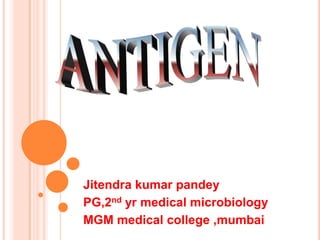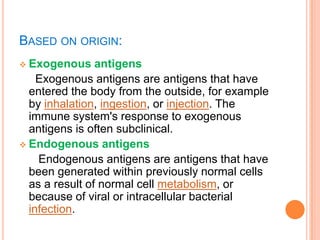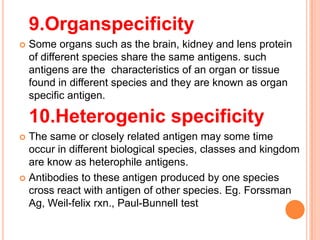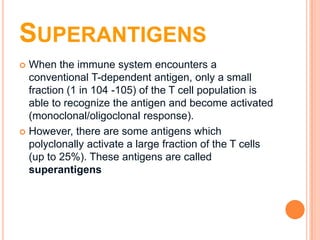- 1. Jitendra kumar pandey
PG,2nd yr medical microbiology
MGM medical college ,mumbai
- 2. INTRODUCTION
In 1899 Ladislas Deutsch (Detre) (1874–1939)
named the hypothetical substances halfway
between bacterial constituents and antibodies
"substances immunogenes or antigenes". He
originally believed those substances to be
precursors of antibodies, just like zymogen is a
precursor of zymase. But by 1903 he understood
that an antigen induces the production of immune
bodies (antibodies) and wrote that the word antigen
was a contraction of "Antisomatogen.
- 3. DEFINITION OF ANTIGEN
Antigen is substance which when introduced parentally
into the body stimulates the production of an antibody
with which it reacts specifically and in an observable
manner
- 5. Based on Immunogenicity
Complete antigen : Substances which can induce antibody
formation by themselves and can react specifically with these
antibodies
Incomplete antigen (haptens): substances unable to
induce antibody formation on its own but can become
immunogenic when covalently linked to proteins,
called carrier proteins .they are of two types:
Complex
Simple
- 6. BASED ON ORIGIN:
Exogenous antigens
Exogenous antigens are antigens that have
entered the body from the outside, for example
by inhalation, ingestion, or injection. The
immune system's response to exogenous
antigens is often subclinical.
Endogenous antigens
Endogenous antigens are antigens that have
been generated within previously normal cells
as a result of normal cell metabolism, or
because of viral or intracellular bacterial
infection.
- 7. Autoantigens
An autoantigen is usually a normal protein or complex of
proteins (and sometimes DNA or RNA) that is recognized
by the immune system of patients suffering from a
specific autoimmune disease. These antigens should,
under normal conditions, not be the target of the immune
system, but, due to mainly genetic and environmental
factors, the normal immunological tolerance for such an
antigen has been lost in these patients.
Isoantigens
Heterophile antigen
- 9. 1.FOREIGNNESS
Antigen must be foreignness to
immune system:
What substances are foreignness to
immune system ?
According to Burnnet’s clone selection
theory , foreignness ( non-self) means
substances that never contact with
lymphocytes during embryo period
- 10. 2.SIZE
Largermolecules are highly antigenic
Lower molecular weight are either non antigenic
or weakly antigenic
3.Chemical Nature
Most naturally occurring antigens are either
proteins or polysaccharides.
Lipids and nucleic acids are less antigenic on
their own but do so when combined with proteins
- 11. 4. SUSCEPTIBILITY TO TISSUE
ENZYMES
Substances which can be metabolised and
are able to the action of tissue enzyme
behave as antigen.
5.Antigenic specificity
Itdepends upon epitope
Position of epitope in the antigen molecule
is important for specificity.
- 12. 6.Species specificity
Tissue of all individual in species possess species
specific antigens.
7.Isospecificity
It depends on isoantigens which may be found in some
but not all members of species.
8.Autospecificity
Self antigens are generally non-antigenic but in some
case such as lens protein and sperm these are not
recognised as self antigen because they are absent
during the embryonic life and develop later.
- 13. 9.Organspecificity
Some organs such as the brain, kidney and lens protein
of different species share the same antigens. such
antigens are the characteristics of an organ or tissue
found in different species and they are known as organ
specific antigen.
10.Heterogenic specificity
The same or closely related antigen may some time
occur in different biological species, classes and kingdom
are know as heterophile antigens.
Antibodies to these antigen produced by one species
cross react with antigen of other species. Eg. Forssman
Ag, Weil-felix rxn., Paul-Bunnell test
- 14. SUPERANTIGENS
When the immune system encounters a
conventional T-dependent antigen, only a small
fraction (1 in 104 -105) of the T cell population is
able to recognize the antigen and become activated
(monoclonal/oligoclonal response).
However, there are some antigens which
polyclonally activate a large fraction of the T cells
(up to 25%). These antigens are called
superantigens
- 15. TESTS FOR ANTIGEN
DETECTION
Direct ELISA
Direct Immunofluoresence
RIA
Neutralization test
CFT
Immunohistochemistry
- 16. THANK YOU !
















